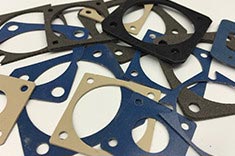EMI Shielding Products
- Custom Gasket Fabrication
- Connector Gaskets
- Bonded O Ring
- Custom Gaskets
- Conduct-O-Knit Knitted Wire Mesh
- Conduct-O-Seal Combo Gasket
- Conduct-O-Elastomer
- Conduct-O-Seal Oriented Wire in Silicone Gasket Material
- Conduct-O-Mesh Tape
- Conduct-O-Foam
- Conduct-O-Bond
- Optical Filters For Electronic Displays
- Shielded Vent Panels
- ESC Board Level Shielding
- 300 Series
The Evolution of Metal-Based EMI Shields
 Metal-based EMI (Electromagnetic Interference) shields have been at the forefront of safeguarding our electronic devices for decades. These shields, primarily derived from metals, serve as a barrier against electromagnetic waves, ensuring the smooth functioning of electronic equipment.
Metal-based EMI (Electromagnetic Interference) shields have been at the forefront of safeguarding our electronic devices for decades. These shields, primarily derived from metals, serve as a barrier against electromagnetic waves, ensuring the smooth functioning of electronic equipment.
Traditional Metal Shields and Their Limitations
Metal in its raw form, such as aluminum film, is a classic choice for creating electronic enclosures. Beyond that, metals are often coated or plated onto electronic parts; a prominent example is nickel. This is because nickel is not only conductive but also boasts ferromagnetic properties. However, there are challenges. These coatings can be prone to scratches, and while minor damage might not hamper their performance due to the long radiation wavelength, it's still a concern.
Moreover, these materials are generally bulky, adding weight and consuming space. They also present design challenges, particularly at joint areas where electromagnetic interference can penetrate. EMI gaskets are used to address this, especially in areas like the door joints of shielded rooms.
Harnessing the Power of Magnetic Alloys
Magnetic alloys have emerged as promising materials for EMI shielding. Permalloy, mu-metal, and ferritic stainless steel are notable examples. Their magnetic properties make them ideal for absorbing electromagnetic waves. However, the drawback is their considerable weight due to their high density. Interestingly, nickel is a magnetic metal, but its relative permeability is low. Still, its adaptability and ease of coating have made it a point of interest for researchers.
Innovative Approaches to EMI Shielding
One progressive strategy has been combining magnetic alloys and conductive yet non-magnetic materials, like carbon. This combination is more effective than using either material type alone. For example, composites containing mu-metal and graphite flakes offer a superior shielding effect. Factors like electrical resistivity can gauge the effectiveness of these composites. The material's magnetic component significantly enhances EMI shielding if the composite's resistivity is less than 10 Ω cm.
The Absorption vs. Reflection Debate
A common understanding of EMI shields is that highly conductive shields mainly rely on reflecting electromagnetic waves. However, recent studies have shown this might not always be accurate. Aluminum, despite its high conductivity, predominantly works through absorption. This has led to revelations about how the electromagnetic interference shielding of materials is influenced by various factors, including their nano and microstructural properties.
For instance, recent research on fibrous nickel with varying diameters has shown that electromagnetic shielding effectiveness is closely related to factors like hysteresis energy loss and coercive force. However, this effectiveness doesn't directly correlate with resistivity or grain size.
As our reliance on electronics grows, the importance of effective EMI shields cannot be overstated. The evolution from traditional metal shields to innovative composites ensures that our devices are protected but also efficient and lightweight. The constant research and innovation in this field are a testament to its critical role in our electronic age.



